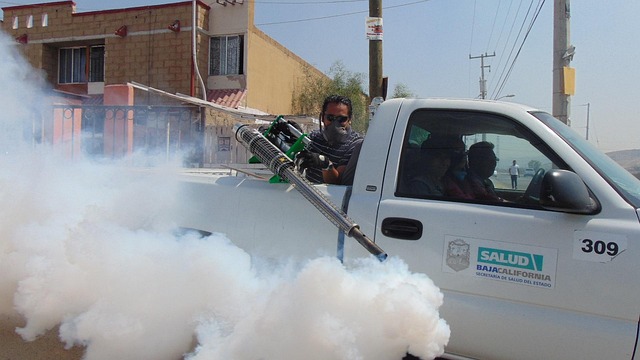Drywood termites, unseen intruders that thrive in dry wood, cause insidious structural damage over time. Professional termite extermination services are vital for detecting and eradicating these hidden colonies. Technicians employ advanced tools like termitometers and smoke detectors, conduct meticulous inspections, identify infested areas, and implement targeted treatments to protect properties from these destructive pests. A swift response after inspection, including customized plans, sealing entry points, regular inspections, ventilation control, and removing food sources, ensures long-term protection against drywood termites.
“Discovering drywood termite colonies early is key to minimizing structural damage. This comprehensive guide explores effective strategies for thorough inspections, empowering homeowners and professionals alike to combat these subtle invaders. We delve into the intricacies of drywood termite behavior, highlighting the indispensable role of professional termite extermination services in detection. Learn a step-by-step process for meticulous inspections and post-inspection actions to ensure long-term protection against these persistent pests.”
Understanding Drywood Termites and Their Colonies
Drywood termites are a specific species that differs from their subterranean counterparts in terms of habitat and feeding behavior. Unlike subterranean termites, which require moisture to survive and typically nest below ground, drywood termites build colonies within dry wood, often in structures like homes, trees, or furniture. These colonies can remain hidden for years, causing significant structural damage unnoticed until it’s severe.
Professional termite extermination services are crucial when dealing with drywood termite infestations. Skilled technicians employ advanced methods to detect these elusive colonies through thorough inspections. They look for telltale signs such as tiny holes in wood, frass (termite droppings), and damaged or hollowed-out wood pieces. By using sensitive equipment and expertise, professionals can identify infested areas, determine the extent of damage, and implement targeted treatments to eradicate colonies effectively, ensuring your property remains protected from these destructive pests.
The Role of Professional Termite Extermination in Detection
Professional termite extermination plays a pivotal role in detecting drywood termite colonies and associated damage. Unlike DIY methods that offer limited visibility, professionals employ advanced techniques such as termitometers, smoke and moisture detectors, and visual inspections with specialized tools. These methods allow for a comprehensive survey of hard-to-reach areas, where drywood termites often establish their colonies.
Expert exterminators are trained to recognize subtle signs of termite activity—from frass (termite waste) and mud tubes to structural anomalies. Their expertise ensures that even hidden or early-stage infestations are identified, preventing further damage to homes and buildings. By enlisting professional services, property owners gain peace of mind, knowing their structures are assessed by seasoned specialists equipped with the latest tools for effective drywood termite detection.
Techniques for Thorough Inspections: A Step-by-Step Guide
Paragraph 1:
When conducting thorough inspections for drywood termite colonies, professionals in termite extermination employ a systematic approach. The process begins with a visual inspection, carefully examining structures for any visible signs of termites or their damage. This includes checking for mud tubes, which are telltale signs of active infestation. Trained exterminators also look for weak or damaged wood, as these areas are more susceptible to termite activity. Using torches or bright lights can help reveal hidden entry points and infestations behind walls or in hard-to-reach corners.
Paragraph 2:
Next, a non-invasive method called moisture meter readings can be utilized to identify potential problem areas. Termites are attracted to moist wood, so identifying damp spots or areas with high humidity is crucial. Additionally, professionals may employ dog detection, where specially trained canines sniff out the distinct scent of termites. This method is highly effective in pinpointing hidden infestations. Once potential colonies are located, further steps can be taken, such as removing infested wood and implementing professional termite extermination treatments to ensure complete elimination and prevent future damage.
Post-Inspection Actions and Maintaining Protection Against Drywood Termites
After a thorough inspection by a trained professional, it’s crucial to take immediate action to address any detected drywood termite colonies and damage. The first step is to implement a professional termite extermination strategy tailored to your specific needs. This may involve targeted treatments, barrier systems, or a combination of both to ensure the termites are eliminated and do not return. It’s important to follow up on any recommendations provided by the exterminator, such as sealing entry points, repairing damaged areas, and scheduling regular inspections to maintain protection against future infestations.
Maintaining a termite-free environment requires ongoing vigilance. Regular inspections by certified professionals are essential to detect any early signs of an infestation. Additionally, property owners should take preventive measures like keeping wood and other potential food sources away from the structure, ensuring proper ventilation, and maintaining moisture control. By combining professional termite extermination with proactive measures, homeowners can safeguard their properties and protect against the costly damage caused by drywood termites.
Detecting drywood termite colonies early is key to mitigating damage. While understanding these subtle invaders and their habits is essential, a professional termite extermination service offers specialized knowledge and advanced techniques for thorough inspections. By following a structured guide and taking post-inspection precautions, homeowners can protect their properties from these relentless pests. Investing in regular professional assessments and timely treatment is crucial for maintaining a drywood termite-free environment. Relying on expert guidance ensures effective prevention and peace of mind.
